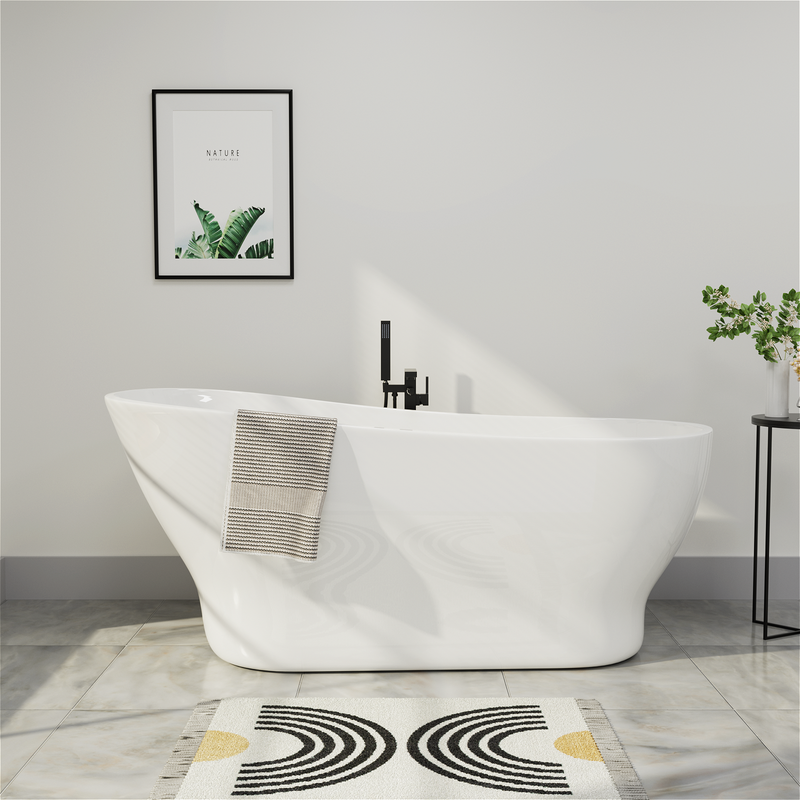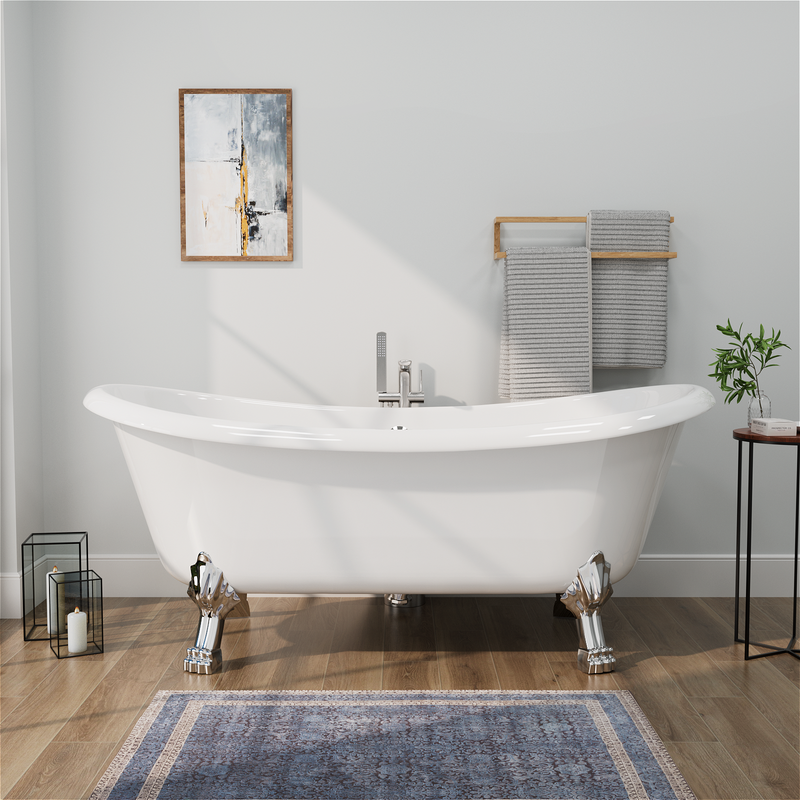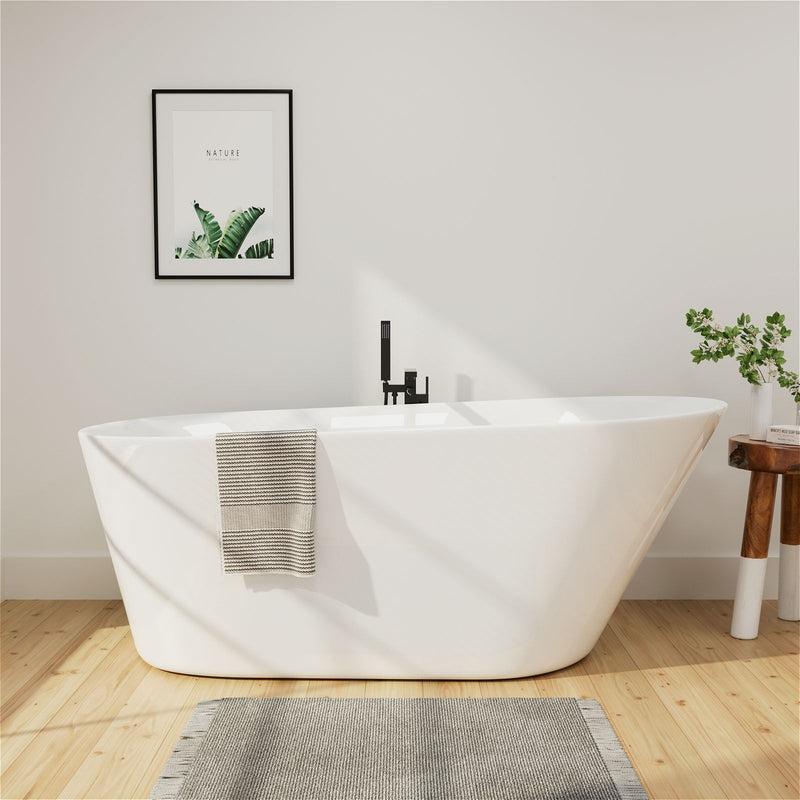When selecting a bathtub, comfort is often a top priority. The oval bathtub, with its distinctive curved shape, has gained popularity for its aesthetic appeal and potential ergonomic benefits. Unlike traditional rectangular tubs, oval designs feature continuous curves that may better align with the natural contours of the human body.
This analysis examines the comfort aspects of oval bathtubs through the lens of ergonomic principles. We'll explore how their unique shape influences support, relaxation, and practical use. Understanding these factors can help you determine whether an oval tub meets your comfort needs and physical requirements, ensuring your bathing experience is both enjoyable and supportive.
The Ergonomic Foundation of Bathtub Design
Ergonomics applies scientific principles to design products that fit the human body's natural movements and proportions. In bathtub design, this means creating shapes that properly support the back, neck, limbs, and spine during immersion. Proper ergonomic design reduces pressure points, minimizes muscle strain, and enhances overall comfort.
The human body in a seated or reclined position requires different support than when standing or sitting upright. Traditional rectangular tubs often feature straight backs and flat bottoms that may not adequately contour to the body's natural curves. Oval bathtubs typically address this through their fundamental shape, which naturally follows the body's rounded forms more closely than angular designs.
How Oval Bathtubs Support Natural Body Positioning
Spinal Alignment and Back Support
The curved interior of an oval bathtub often provides superior spinal support compared to flat-backed alternatives. The continuous curved surface cradles the entire back from shoulders to hips, distributing body weight more evenly and reducing pressure on specific points. This comprehensive support system helps maintain the spine's natural S-curve during bathing, which is particularly important for extended soaks.

The raised back commonly found in slipper-style oval tubs offers additional neck and shoulder support. This elevated design allows bathers to recline at a more natural angle without straining neck muscles. The curved sides of oval tubs also provide arm support in multiple positions, whether resting at your sides or positioned slightly outward.
Legroom and Limb Positioning
Oval bathtubs typically offer more functional legroom than similarly sized rectangular models. The curved ends create additional space for knee bending and leg extension without the confinement of sharp corners. This spacious design accommodates various seating positions, from fully extended to slightly bent knees, which can reduce pressure on the lower back and hips.
The absence of corners allows for more natural leg movement and position changes during bathing. This freedom of movement prevents the restricted feeling that some bathers experience in traditional tubs. The smooth, continuous interior surface also eliminates potential pressure points that can develop when limbs press against angled corners.
Comparative Comfort: Oval Versus Traditional Tub Shapes
Rectangular bathtubs have dominated bathroom design for decades, but their straight lines and sharp corners don't necessarily align with optimal comfort. The right-angled corners of traditional tubs often create uncomfortable pressure points for knees and elbows, while the flat back may provide inadequate support for the spine's natural curvature.
Oval tubs address these limitations through their fundamentally different geometry. The continuous curved surface eliminates pressure points at corners while providing more consistent support along the entire body length. The rounded ends allow for more natural leg positioning, whether fully extended or comfortably bent. This shape difference becomes particularly important for taller individuals who may find rectangular tubs too confining.
The interior proportions of oval tubs often provide greater functional space than their rectangular counterparts with similar exterior dimensions. The curved sides create the visual and physical perception of more room, while the elimination of corners increases usable space. This efficient use of interior volume means bathers can enjoy a more spacious feeling without requiring a larger overall tub footprint.
Material Considerations in Oval Bathtub Comfort
Thermal Properties
The material composition of an oval bathtub significantly impacts comfort, particularly regarding heat retention. Acrylic, commonly used in oval tub construction, provides excellent thermal properties that keep water warmer for longer periods compared to metal or ceramic materials. This extended heat retention enhances comfort during longer bathing sessions by maintaining consistent water temperature.
The warm-to-the-touch quality of materials like acrylic also improves initial comfort when entering the tub. Unlike metal or porcelain surfaces that can feel cold initially, acrylic quickly adjusts to body temperature, eliminating the discomfort of touching cold surfaces. This material characteristic contributes significantly to the overall comfort experience from the moment of entry.
Surface Texture and Body Contact
The interior finish of an oval bathtub plays a crucial role in skin contact comfort. Smooth, non-porous surfaces feel more comfortable against bare skin than textured or porous alternatives. High-quality acrylic finishes provide a consistently smooth contact surface that's gentle on skin while being easy to clean and maintain.
The slight flexibility of materials like acrylic can offer subtle give that some bathers find more comfortable than completely rigid surfaces. This minimal flexibility provides a slight cushioning effect that may reduce pressure points. However, the material must maintain sufficient rigidity to ensure structural integrity and prevent feeling insubstantial during use.
Size Variations and Their Impact on Comfort
Standard Oval Tub Dimensions
Oval bathtubs typically range from 55 to 72 inches in length, with widths varying from 30 to 42 inches. The comfort level within these dimensions depends significantly on the bather's height and body type. Taller individuals generally require longer oval tubs to achieve proper full-body support without cramped positioning.
The interior depth of an oval tub significantly influences immersion comfort. Deeper models allow for more complete water coverage, which enhances heat retention and provides better floating support. However, very deep tubs may present accessibility challenges for some users, highlighting the importance of balancing depth with practical entry and exit considerations.
Finding the Right Size for Your Body
Selecting an appropriately sized oval tub involves considering both physical dimensions and personal comfort preferences. Taller bathers should prioritize length to ensure adequate legroom and spinal support, while broader-shouldered individuals may require greater width for comfortable arm positioning. The relationship between exterior dimensions and interior space efficiency makes oval tubs particularly suitable for various body types.
Comfort also depends on the intended bathing position. Those who prefer fully extended soaking need different dimensions than bathers who enjoy a more seated, upright position. The curved design of oval tubs often accommodates multiple positions more effectively than rectangular alternatives, providing flexibility in bathing experiences.
Accessibility and Ease of Use
Entry and Exit Considerations
The curved rim of an oval bathtub can facilitate easier entry and exit compared to higher-walled rectangular models. The consistent height around the entire perimeter provides multiple access points, allowing users to choose the most comfortable entry method. However, the rounded shape may offer fewer flat surfaces for hand support during transitions.
Some oval tub designs incorporate graduated sides or integrated steps to improve accessibility. These features can significantly enhance safety and comfort for users with mobility challenges. The absence of sharp corners also reduces injury risk during entry and exit movements, particularly in confined bathroom spaces.
Interior Stability and Movement
The smooth, continuous interior surface of oval tubs provides consistent footing and reduces tripping hazards. Unlike rectangular tubs with corner junctions that can create uneven footing, oval interiors offer uniform support across the entire base. This consistency becomes particularly important when changing positions or rising from a seated posture.
The curved walls of oval tubs may provide additional bracing points for stability during position changes. The gentle slope offers natural handholds that can assist with controlled movement within the tub. However, properly placed grab bars remain essential for safety, particularly for users with balance concerns or limited mobility.
Mokleba's Approach to Ergonomic Oval Tub Design
Mokleba's oval tub designs incorporate specific ergonomic principles to enhance comfort and usability. Our approach focuses on creating contours that support the body's natural positioning while maintaining efficient spatial dimensions. The careful balancing of curvature and structure aims to provide both immediate comfort and long-term satisfaction.

We recognize that comfort varies among individuals, which is why our oval tub collection includes multiple size profiles to accommodate different body types and preferences. The consistent focus on ergonomic principles across our product line ensures that each tub provides proper spinal support, adequate legroom, and comfortable arm positioning. This commitment to thoughtful design results in oval tubs that genuinely enhance the bathing experience through science-based comfort.
FAQs
What makes oval bathtubs more comfortable than rectangular ones?
The curved shape of oval bathtubs better conforms to the body's natural contours, providing more consistent spinal support and eliminating pressure points from corners. The continuous curved surface distributes body weight more evenly, reducing strain on specific areas during extended soaks.
Are oval bathtubs suitable for people with back pain?
The comprehensive back support provided by curved oval tub designs can benefit some individuals with back pain. The even weight distribution and spinal alignment may reduce discomfort, though individual experiences vary. Consult with a healthcare provider regarding your specific condition.
How does the material of an oval tub affect comfort?
Materials like acrylic provide warm-to-the-touch surfaces and better heat retention than metal or ceramic. This maintains more consistent water temperature and eliminates the initial cold contact that can be uncomfortable. The slight flexibility of quality acrylic also offers minimal cushioning.
What size oval tub is most comfortable for tall people?
Taller individuals generally find oval tubs of 66 inches or longer most comfortable. The curved ends provide additional legroom compared to rectangular tubs of similar length, allowing for more natural leg positioning whether extended or bent.
Do oval bathtubs provide adequate shoulder support?
The curved sides of oval tubs typically offer good shoulder support in multiple positions. The continuous curved surface cradles shoulders more naturally than flat-backed rectangular tubs, though individual fit depends on specific body proportions and tub dimensions.
Are oval tubs easier to get in and out of than rectangular tubs?
The consistent height around oval tubs provides multiple entry points, which can be advantageous. However, the rounded shape may offer fewer flat surfaces for hand support. Overall accessibility depends on specific design features like rim height and available support structures.
How does oval tub depth impact comfort?
Deeper oval tubs provide more complete water immersion, enhancing warmth and buoyancy. However, very deep models may present entry challenges. Most users find depths between 18-22 inches provide good immersion while maintaining practical accessibility.
Conclusion: Evaluating Oval Bathtub Comfort
Oval bathtubs offer distinct ergonomic advantages that can significantly enhance bathing comfort for many users. Their curved design naturally aligns with human body contours, providing superior spinal support and eliminating the pressure points associated with angular corners. The efficient use of interior space creates a more generous feeling bathing environment without increasing exterior dimensions.
Comfort remains subjective, and individual preferences vary based on body type, mobility, and personal bathing habits. However, the fundamental design principles of oval tubs address key ergonomic considerations that contribute to physical comfort and relaxation. When properly sized and positioned, an oval bathtub can transform ordinary bathing into a truly comfortable, supportive experience that combines form and function through thoughtful design.





